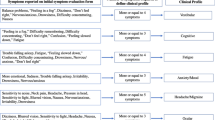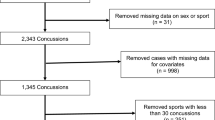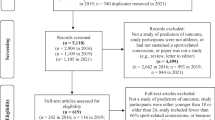Abstract
Background
Sport-related concussion is recognized as a significant injury with variable recovery rates.
Objective
This study defined the acute natural history of sport concussion in male and female collegiate athletes participating in a broad array of sports.
Methods
We conducted a prospective, longitudinal investigation among collegiate student athletes (n = 34,709) from 30 academic institutions. Primary outcomes included the time (days) from injury until initiation of a return to participation (RTP) protocol and time from injury until medical clearance for unrestricted RTP.
Results
Concussed athletes (n = 1751, 19.2 years, 63.2% male) participating in 22 different sports began the RTP protocol in a median 6.4 (IQR 3.7–11.8) days. Time to initiate the RTP protocol was lengthened by less frequent post-injury assessments, greater initial post-injury symptom severity, limited contact sports participation, practice/training injuries, and three or more prior concussions. The median total RTP duration was 12.8 (IQR 8.7–20.1) days. Total RTP duration was shorter with ADHD medication usage, males, and greater assessment frequency; while greater initial post-injury symptom severity, practice-/training-related injuries, and three or more prior concussions had longer recoveries.
Conclusion
Although median recovery times are consistent with previous guidelines, it was not until 1 month post-injury that a preponderance of collegiate athletes were cleared to begin the RTP protocol (92%) or cleared for unrestricted sport participation (85%). Intrinsic and extrinsic factors had a small effect, altering recovery trajectories by up to 2 days, suggesting a largely unified approach to post-injury monitoring and management across all athletes. These data represent a shift from previous classification parameters of normal clinical recovery.


Similar content being viewed by others
References
Broglio SP, Cantu RC, Gioia GA, Guskiewicz KM, Kutcher J, Palm M, et al. National Athletic Trainers’ Association position statement: management of sport concussion. J Athl Train. 2014;49(2):245–65.
Harmon KG, Clugston JR, Dec K, Hainline B, Herring S, Kane SF, et al. American Medical Society for Sports Medicine position statement on concussion in sport. Br J Sports Med. 2019;53(4):213–25.
McCrory P, Meeuwisse W, Dvorak J, Aubry M, Bailes J, Broglio S, et al. Consensus statement on concussion in sport-the 5(th) international conference on concussion in sport held in Berlin, October 2016. Br J Sports Med. 2017;51(11):838–47.
Iverson GL, Gardner AJ, Terry DP, Ponsford JL, Sills AK, Broshek DK, et al. Predictors of clinical recovery from concussion: a systematic review. Br J Sports Med. 2017;51(12):941–8.
Guskiewicz KM, McCrea M, Marshall SW, Cantu RC, Randolph C, Barr W, et al. Cumulative effects associated with recurrent concussion in collegiate football players: the NCAA Concussion Study. JAMA. 2003;290(19):2549–55.
Nelson LD, Tarima S, LaRoche AA, Hammeke TA, Barr WB, Guskiewicz K, et al. Preinjury somatization symptoms contribute to clinical recovery after sport-related concussion. Neurology. 2016;86(20):1856–63.
Broglio SP, McCrea M, McAllister T, Harezlak J, Katz B, Hack D, et al. A National Study on the effects of concussion in collegiate athletes and US Military Service Academy Members: The NCAA-DoD Concussion Assessment, Research and Education (CARE) Consortium structure and methods. Sports Med. 2017;47(7):1437–51.
Rice SG. American Academy of Pediatrics Council on Sports M, Fitness. Medical conditions affecting sports participation. Pediatrics. 2008;121(4):841–8.
Carney N, Ghajar J, Jagoda A, Bedrick S, Davis-O’Reilly C, du Coudray H, et al. Concussion guidelines step 1: systematic review of prevalent indicators. Neurosurgery. 2014;75(Suppl 1):S3-15.
Van Pelt KL, Allred D, Cameron KL, Campbell DE, D’Lauro CJ, He X, et al. A cohort study to identify and evaluate concussion risk factors across multiple injury settings: findings from the CARE Consortium. Inj Epidemiol. 2019;6(1):1.
Mickey RM, Greenland S. The impact of confounder selection criteria on effect estimation. Am J Epidemiol. 1989;129(1):125–37.
McCrea M, Guskiewicz K, Randolph C, Barr WB, Hammeke TA, Marshall SW, et al. Incidence, clinical course, and predictors of prolonged recovery time following sport-related concussion in high school and college athletes. J Int Neuropsychol Soc. 2013;19(1):22–33.
Master CL, Katz BP, Arbogast KB, McCrea MA, McAllister TW, Pasquina PF, Lapradd M, Zhou W, Broglio SP, CARE Consortium Investigators. Differences in sport-related concussion for female and male athletes in comparable collegiate sports: a study from the NCAA-DoD Concussion Assessment, Research and Education (CARE) Consortium. Br J Sports Med. 2020;. https://doi.org/10.1136/bjsports-2020-103316.
McCrea M, Broglio S, McAllister T, Zhou W, Zhao S, Katz B, et al. Return to play and risk of repeat concussion in collegiate football players: comparative analysis from the NCAA Concussion Study (1999–2001) and CARE Consortium (2014–2017). Br J Sports Med. 2020;54(2):102–9.
Henry LC, Elbin RJ, Collins MW, Marchetti G, Kontos AP. Examining recovery trajectories after sport-related concussion with a multimodal clinical assessment approach. Neurosurgery. 2016;78(2):232–41.
McCrea M, Guskiewicz KM, Marshall SW, Barr W, Randolph C, Cantu RC, et al. Acute effects and recovery time following concussion in collegiate football players: the NCAA Concussion Study. JAMA. 2003;290(19):2556–63.
Gibson TB, Herring SA, Kutcher JS, Broglio SP. Analyzing the effect of state legislation on health care utilization for children with concussion. JAMA Pediatr. 2015;169(2):163–8.
Wasserman EB, Kerr ZY, Zuckerman SL, Covassin T. Epidemiology of sports-related concussions in National Collegiate Athletic Association Athletes from 2009–2010 to 2013–2014: symptom prevalence, symptom resolution time, and return-to-play time. Am J Sports Med. 2016;44(1):226–33.
Zemek R, Barrowman N, Freedman SB, Gravel J, Gagnon I, McGahern C, et al. Clinical risk score for persistent postconcussion symptoms among children with acute concussion in the ED. JAMA. 2016;315(10):1014–25.
Ledoux AA, Tang K, Yeates KO, Pusic MV, Boutis K, Craig WR, et al. Natural progression of symptom change and recovery from concussion in a pediatric population. JAMA Pediatr. 2019;173(1): e183820.
Williams RM, Puetz TW, Giza CC, Broglio SP. Concussion recovery time among high school and collegiate athletes: a systematic review and meta-analysis. Sports Med. 2015;45(6):893–903.
Kerr ZY, Register-Mihalik JK, Kroshus E, Baugh CM, Marshall SW. Motivations associated with nondisclosure of self-reported concussions in former collegiate athletes. Am J Sports Med. 2016;44(1):220–5.
Asken BM, Bauer RM, Guskiewicz KM, McCrea MA, Schmidt JD, Giza CC, et al. Immediate removal from activity after sport-related concussion is associated with shorter clinical recovery and less severe symptoms in collegiate student-athletes. Am J Sports Med. 2018;46(6):1465–74.
Mustafi SM, Harezlak J, Koch KM, Nencka AS, Meier TB, West JD, et al. Acute white-matter abnormalities in sports-related concussion: a diffusion tensor imaging study from the NCAA-DoD CARE consortium. J Neurotrauma. 2018;35(22):2653–64.
Taylor E, Dopfner M, Sergeant J, Asherson P, Banaschewski T, Buitelaar J, et al. European clinical guidelines for hyperkinetic disorder—first upgrade. Eur Child Adolesc Psychiatry. 2004;13(Suppl 1):I7-30.
Beauchamp MH, Aglipay M, Yeates KO, Desire N, Keightley M, Anderson P, et al. Predictors of neuropsychological outcome after pediatric concussion. Neuropsychology. 2018;32(4):495–508.
Zuckerman SL, Kerr ZY, Yengo-Kahn A, Wasserman E, Covassin T, Solomon GS. Epidemiology of sports-related concussion in NCAA athletes from 2009–2010 to 2013–2014: incidence, recurrence, and mechanisms. Am J Sports Med. 2015;43(11):2654–62.
Covassin T, Elbin RJ, Harris W, Parker T, Kontos A. The role of age and sex in symptoms, neurocognitive performance, and postural stability in athletes after concussion. Am J Sports Med. 2012;40(6):1303–12.
Black AM, Sergio LE, Macpherson AK. The epidemiology of concussions: number and nature of concussions and time to recovery among female and male Canadian varsity athletes 2008 to 2011. Clin J Sport Med. 2017;27(1):52–6.
Yeates KO, Tang K, Barrowman N, Freedman SB, Gravel J, Gagnon I, et al. Derivation and initial validation of clinical phenotypes of children presenting with concussion acutely in the emergency department: latent class analysis of a multi-center, prospective cohort. Observational Study. J Neurotrauma. 2019;36(11):1758–67.
Bazarian JJ, Blyth B, Mookerjee S, He H, McDermott MP. Sex differences in outcome after mild traumatic brain injury. J Neurotrauma. 2010;27(3):527–39.
Stephens JA, Liu P, Lu H, Suskauer SJ. Cerebral blood flow after mild traumatic brain injury: associations between symptoms and post-injury perfusion. J Neurotrauma. 2018;35(2):241–8.
Kamins J, Bigler E, Covassin T, Henry L, Kemp S, Leddy JJ, et al. What is the physiological time to recovery after concussion? A systematic review. Br J Sports Med. 2017;51(12):935–40.
McCrea M, Meier T, Huber D, Ptito A, Bigler E, Debert CT, et al. Role of advanced neuroimaging, fluid biomarkers and genetic testing in the assessment of sport-related concussion: a systematic review. Br J Sports Med. 2017;51(12):919–29.
Acknowledgements
The authors would like to thank Ryan Tierney (Temple University), Patrick O'Donnell (United States Coast Guard Academy), Josh Goldman (University of California at Los Angeles), Kevin Guskiewicz (University of North Carolina at Chapel Hill), Mickey Collins (University of Pittsburgh), Jeff Bazarian (University of Rochester), Laura Lintner (Wake Forest University), Brian Dyhuizen (Wilmington College), Paul Pasquina (Uniformed Services University), Jaroslaw Harezlak, Jody Harland, Janetta Matesan, and Larry Riggen (Indiana University), Nicole L’Heureux and Ashley Rettmann (University of Michigan), Melissa Koschnitzke (Medical College of Wisconsin), Michael Jarrett, Vibeke Brinck, and Bianca Byrne (Quesgen), Thomas Dompier, Christy Collins, Melissa Baker, and Sara Quetant (Datalys Center for Sports Injury Research and Prevention), and the research and medical staff at each of the participating sites.
CARE Consortium Investigators include (alphabetical by institution): April Hoy MS, ATC, CSCS (Azusa Pacific University), Joseph B. Hazzard, EdD, ATC (Bloomsburg University), Louise A. Kelly, PhD (California Lutheran University), John DiFiori, MD (Hospital for Special Surgery), Justus D. Ortega, PhD (Humbolt State University), Nicholas Port, PhD (Indiana University), Margot Putukian (Princeton University), Dianne Langford, PhD and Jane McDevitt PhD, ATC, CSCS (Temple University), Darren Campbell, MD, Jonathan C. Jackson, MD, and Gerald McGinty, PT, DPT (United States Air Force Academy), Carlos Estevez, DPT (United States Coast Guard Academy), Kenneth L. Cameron, PhD, MPH, ATC, Megan N. Houston, PhD, ATC, and Steven J. Svoboda, MD (United States Military Academy), Adam James Susmarski, DO (United States Naval Academy), Chris Giza, MD (University of California at Los Angeles), Holly J. Benjamin, MD (University of Chicago), Thomas W. Kaminski, PhD, ATC and Thomas Buckley, EdD, ATC (University of Delaware), James R. Clugston, MD, MS, CAQSM (University of Florida), Julianne Schmidt, PhD, ATC (University of Georgia), Luis A. Feigenbaum, PT, DPT, ATC (University of Miami), J. T. Eckner, MD (University of Michigan), Jason Mihalik, PhD, CAT(C), ATC (University of North Carolina at Chapel Hill), Jessica Dysart Miles, PhD, ATC (University of North Georgia), Scott Anderson, ATC (University of Oklahoma), Kristy Arbogast, PhD and Christina L. Master, MD, CAQSM (University of Pennsylvania), Anthony P. Kontos, PhD (University of Pittsburgh), Sara P. D. Chrisman, MD, MPH (University of Washington), M. Alison Brooks, MD MPH (University of Wisconsin-Madison), Steve Rowson, PhD and Stefan M. Duma, PhD (Virginia Tech), Chris Miles, MD (Wake Forest University).
Author information
Authors and Affiliations
Consortia
Corresponding author
Ethics declarations
Funding
Data collection and sharing for this project was conducted with support from the National Collegiate Athletic Association (NCAA) and the Department of Defense (DOD). The U.S. Army Medical Research Acquisition Activity, 820 Chandler Street, Fort Detrick MD 21702-5014, is the awarding and administering acquisition office. This work was supported by the Office of the Assistant Secretary of Defense for Health Affairs, through the Combat Casualty Care Research Program, endorsed by the Department of Defense, through the Joint Program Committee 6/Combat Casualty Care Research Program—Psychological Health and Traumatic Brain Injury Program under Award No. W81XWH1420151. Opinions, interpretations, conclusions and recommendations are those of the authors and are not necessarily endorsed by the Department of Defense.
Author Contributions
SB, TM, MM contributed to the design and implementation of the investigation, drafting and revision of the manuscript; BK contributed to the design and implementation of the investigation, statistical analyses and interpretation, and drafting and revision of the manuscript; MLP and WZ contributed to the statistical analyses and interpretation, and drafting and revision of the manuscript; CARE Consortium Investigators contributed to the implementation of the investigation and revision of the manuscript.
Conflicts of interest/Competing interests
Steven Broglio, Thomas McAllister, Barry Katz, Michelle LaPradd, Wenxian Zhou, and Michael McCrea received funding from the NCAA and the Department of Defense to complete this investigation and to cover travel costs related to the study.
Ethics approval
This study was completed following approval from respective local Institutional Review Boards and the United States Army Human Research Protection Office. This study was conducted in accordance with the Declaration of Helsinki.
Availability of data
Data used in this investigation are available in the Federal Interagency Traumatic Brain Injury Research (FITBIR) Informatics System (https://fitbir.nih.gov/).
Code availability
The specific analytic coding that was used relies on the data set prepared from the full data set of over 38,000 participants, but the analytic techniques used are standard (e.g. Cox proportional hazards models) and available in all statistical software packages. For those interested, the authors can be contacted for the code and with questions.
Additional information
This article is part of a Collection on The NCAA-DoD Concussion Assessment, Research and Education (CARE) Consortium.
The members of “CARE Consortium Investigators” is present in Acknowledgements section.
Supplementary Information
Below is the link to the electronic supplementary material.
Rights and permissions
About this article
Cite this article
Broglio, S.P., McAllister, T., Katz, B.P. et al. The Natural History of Sport-Related Concussion in Collegiate Athletes: Findings from the NCAA-DoD CARE Consortium. Sports Med 52, 403–415 (2022). https://doi.org/10.1007/s40279-021-01541-7
Accepted:
Published:
Issue Date:
DOI: https://doi.org/10.1007/s40279-021-01541-7




